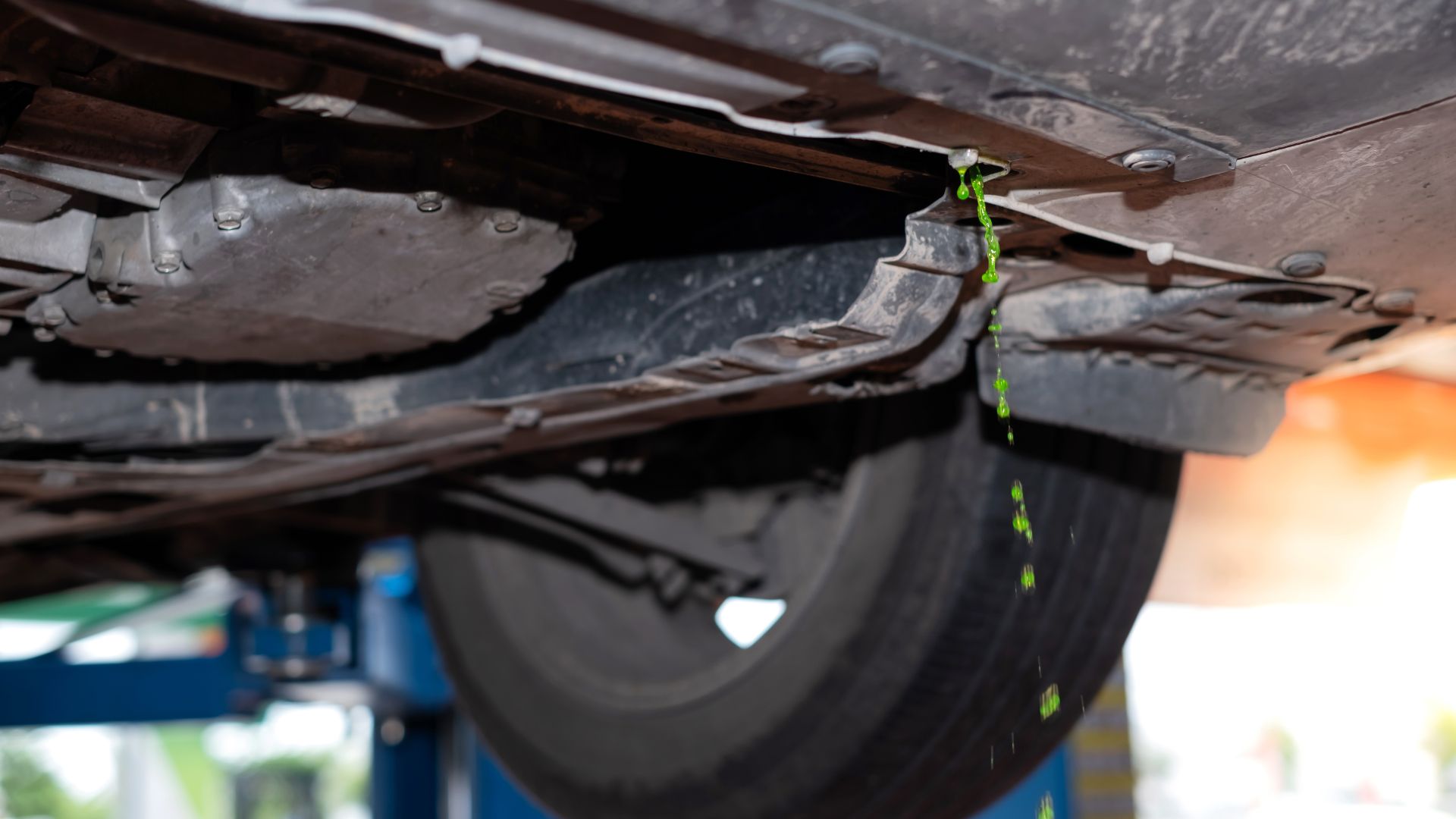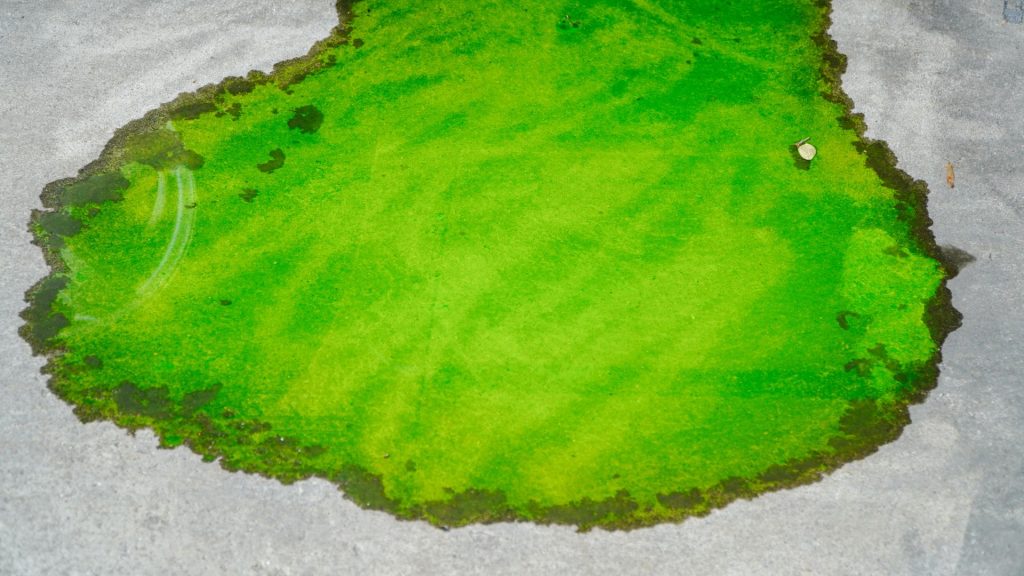Green liquid leaking from car — causes and fixes
Investigate the surprising reasons behind the mysterious green liquid leaking from your car.

Nothing is more disturbing than seeing a puddle of an unknown liquid under your car after you left it in good shape. This puddle of liquid is not safe for your vehicle and is typically an indication of a fluid leak. The fluid could be anything from a power steering fluid to engine oil.
Your vehicle is a sophisticated machine that needs various fluids to function adequately. Any of these essential fluids can leak anytime, and you can identify which fluid is leaking by observing the color, texture, and sometimes odor.
When you notice that your car is leaking fluid, you need to visit a mechanic to carry out a full inspection to avoid being stranded on the highway waiting to get towed. You can assess it yourself by determining the location and amount of the fluid leakage.
To do this, you should put a piece of cardboard under your car overnight. Check the cardboard the following day to know where the fluid is coming from, what color it is, and the amount leaked out. In this article, we will discuss the causes and fixes of green liquid leaking from a car.
Where is the green liquid leaking from my car?
A green liquid leaking from your car always indicates an antifreeze. An antifreeze leak is one of the most prevalent leaks in many vehicles. This leak typically comes from a hose or clamp not attached appropriately.
The coolant or antifreeze regulates the engine temperature and keeps it from overheating. When you notice a green fluid under your car, you should take your vehicle to a mechanic for a proper inspection. Leaks are common symptoms of low coolant and you may risk ending up with an overheating engine if you don’t deal with the issue right away. If the green liquid isn’t an antifreeze, it will most likely be an A/C fluid leaking from your car.
Visit an auto repair shop to carry out a complete diagnosis of the leak. The leak can get sealed by removing the refrigerant from the A/C and then replacing it once the leak gets salvaged. The service cost ranges from $250 to $400.
Some of the internal motor parts may get worn out, and this causes the antifreeze to leak. Using the wrong antifreeze for your vehicle can cause leakage to occur. Ignoring the green fluid leak can be risky as it jeopardizes your engine overheating and getting damaged. It also increases the bill for repairs.
Why is a green fluid leaking from my car?

There are several reasons why a green fluid is leaking from your car. Some significant reasons include;
Hole or tear in the radiator
Corrosion or rust causes a hole in the radiator, and it is one of the most significant reasons why you have a green fluid leaking from your vehicle. A worn-out hose can piece sediment and debris in it, and this can cause a leak.
The gasket that seals the space between the radiator and your tank can become faulty over a long period, making the coolant leak. The hoses and clamps connected to the engine radiator can cause a problem if used for an extended period.
Blown head gasket
A decent head gasket significantly affects how your engine functions efficiently. When the head gasket blows up, it may be unidentified for a while. You could be driving for an extended time without noticing the issue. The head gasket withstands extreme pressure and temperature experienced in your engine. It is found between the cylinder and the engine system, and if there is a leakage, you can say it is damaged or blown.
If the gasket gets damaged, you cannot keep the engine oil and the coolant separate. This is quite harmful and could result in your engine getting damaged and coolant seeping out from the engine system, causing the coolant level to drop. This causes your vehicle to overheat.
Leaky radiator cap
A radiator cap is vital in the cooling system, even if small. It formulates a tight seal to keep the cooling system in check at the proper pressure, as the radiator is vastly pressurized. Over time, the developed seal gets weak, and the springs start wearing out, causing the coolant or antifreeze to leak out of the radiator.
Faulty expansion tank
The expansion tank is a plastic container at the side of the engine. It plays a significant role in supplying coolant to the radiator. There is a hose that connects the expansion tank to the radiator.
The expansion tank accepts and supplies coolant throughout the radiator as the engine heats up or cools down. Over time, and after many temperature changes, the expansion tank and other components connected to it begin to wear. The tank can get cracked, or its lid can get leaked. It could result from a loose connection from a deteriorated hose that allows the fluid to seep through.
Damaged water pump
Water pumps are designed to circulate coolant around the cooling system. They are located close to the drive belt on the lower side engine block. Water pumps are connected to the lower radiator hoses, although the connection can wear out or become loose over time.
It can also get damaged by other external factors that may cause it to leak. When a water pump develops a fault that hinders its functioning, the engine becomes prone to overheating.
Should I be worried if my car is leaking green fluid?
When a car is leaking green fluid, it is usually antifreeze. The leak has to undergo an inspection and get repaired as soon as possible. A green fluid leaking from a car means there’s a problem with the radiator, water pump, or expansion tank.
There is a significant concern when a small leakage suddenly becomes a massive leak, and this will cause the engine to overheat more or less instantly. An overheating problem poses potential engine damage. Of course, it’s sometimes more difficult to determine the cause, just like with pink fluid leaks from the car that can be either power steering fluid or coolant.
If the leakage is from the water pump bearing, the pump is on the brink of failure, resulting in an overheating situation. It could also snap or damage the drive belt. You must visit a mechanic for an inspection once you notice the leak to get repairs done to save you from further damage.
Can I drive my car if it is leaking green fluid?
If a greenish-blue or green fluid leaks from your car, it is an antifreeze or coolant. Do not drive your vehicle if there is an antifreeze leakage. As the coolant leaks from the cooling system, your engine starts to overheat, and the engine oil temperature can also heat up.
If the antifreeze leaks onto a hot exhaust, it could create a fire outbreak. You can drive to the nearest auto repair shop that isn’t more than ten miles away. This short distance is less likely to heat the engine to start a fire.
If you fail to fix the leaking issue, there will be damage to the rubber hose, seals, and other components. It would help if you tried to get the leak repaired immediately.
How to fix green fluid leaking from a car
Replacing faulty components is the best way of preventing the green fluid from leaking. However, there are some procedures you can try out to resolve the leaking.
Replace clamps
The clamps are responsible for holding the hoses together. If they are affected by corrosion, they must be replaced as soon as possible. Detect the faulty clamp and check if you will need to replace it.
Empty the coolant into a can and get hold of the defective clamp. Discard the worn-out clamp and the damaged hoses as well. Replace it with a new one and connect them back together. It would help if you refilled the radiator and tightened the lid. Test drive your car and check if it has an average working temperature.
Change radiator
There are different styles of installing a radiator, though the steps for the replacement are similar. Firstly, your vehicle needs to cool down before detaching the car battery. Remove the plug from the radiator’s lower part and drain the coolant from the cooling system.
Confirm that coolant is disposed of adequately. Pull out any hoses connecting the radiator to the engine and remove the thermostat. If there is a fixed fan to the radiator, remove it.
The bolts that secure the radiator to its position should also be removed. You take out the damaged radiator and replace it with a new one. Reassemble the components, replace any damaged parts, fill the radiator with a new coolant, and turn on the engine to determine if there are any more leaks.
Our take
If you notice drops or a puddle of green fluid under your vehicle, it will likely be an antifreeze. Antifreeze can leak out of your vehicle’s radiator, water pumps, clamps, hoses, and other components that get worn out or aren’t correctly connected.
You should have your car thoroughly inspected when you notice a leakage, it can help prevent the potential risk of engine damage and other car problems, and it also keeps you from spending on repair bills.
What is the green liquid leaking from my car?
The green liquid leaking from your car is most likely antifreeze or A.C. fluid.
What does it mean when a car is leaking green fluid?
When a car is leaking green fluid, it means there’s a problem with the radiator, water pump, or expansion tank.
Should I drive my car if it is leaking green fluid?
You should not drive your car if it is leaking green fluid, as it could result in a fire outbreak or cause further damage to your vehicle.